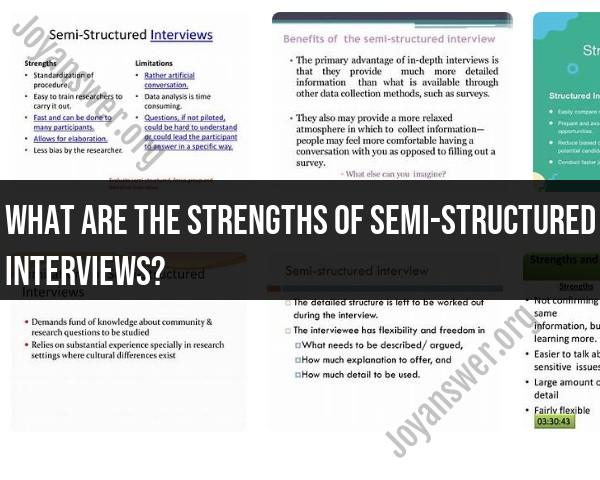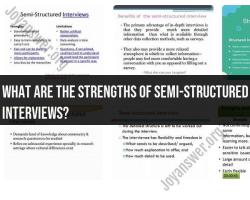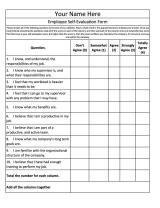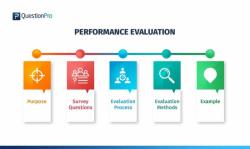What are the strengths of semi-structured interviews?
Semi-structured interviews offer a flexible and adaptable approach to data collection, combining elements of both structured and unstructured interview formats. Here are some strengths of semi-structured interviews:
Flexibility:
- One of the key strengths of semi-structured interviews is their flexibility. The interviewer has a set of predetermined questions but can also deviate from the script to explore interesting or unexpected responses. This flexibility allows for a more dynamic and in-depth conversation.
Depth of Understanding:
- Semi-structured interviews often provide a deeper understanding of the participants' perspectives, experiences, and attitudes. The open-ended nature of some questions allows respondents to express themselves more freely, leading to richer and more nuanced data.
Personalization:
- Interviewers can tailor questions to the specific context or individual, making the interview more personalized. This can help build rapport between the interviewer and the participant, creating a more comfortable and open atmosphere for discussion.
Opportunity for Clarification:
- If a participant provides a response that requires clarification or further exploration, the interviewer can follow up with additional questions. This allows for a more thorough examination of complex or ambiguous responses.
Participant Engagement:
- Participants may feel more engaged in the interview process because they have the freedom to express themselves in their own words. This can lead to more authentic responses and a higher level of participant involvement.
Cultural Sensitivity:
- Semi-structured interviews can be adapted to be culturally sensitive. Interviewers can adjust their approach based on cultural nuances and the communication styles of participants, contributing to better cross-cultural research.
Exploration of New Themes:
- Researchers can explore emerging themes or unexpected findings during the interview. This adaptability is particularly beneficial when studying complex or evolving phenomena where fixed survey questions may not capture all relevant aspects.
Suitability for Qualitative Research:
- Semi-structured interviews are well-suited for qualitative research, allowing researchers to gather rich, detailed data that can be analyzed in-depth. This approach is valuable for exploring the meaning and context behind participants' experiences.
Time Efficiency:
- While more flexible than structured interviews, semi-structured interviews can still be more time-efficient than fully unstructured interviews. The predetermined questions provide a framework, helping to maintain focus and guide the conversation.
Triangulation:
- Semi-structured interviews can be part of a triangulation strategy, where multiple data sources and methods are used to enhance the reliability and validity of research findings. Combining interviews with other data collection methods adds depth to the study.
These strengths make semi-structured interviews a valuable tool in qualitative research, particularly when exploring complex or multifaceted phenomena where a more open-ended and adaptable approach is advantageous.
Advantages or Strengths of Conducting Semi-Structured Interviews
Flexibility and Adaptability: Semi-structured interviews allow for flexibility in adapting the interview to the respondent's unique experiences and perspectives. This adaptability enables researchers to gather rich and nuanced data that may not be captured by a rigid, structured approach.
Deep Exploration of Topics: Semi-structured interviews provide a platform for in-depth exploration of topics, allowing researchers to delve into the nuances of respondents' thoughts, feelings, and experiences. This depth of understanding is often difficult to achieve with other interview formats.
Contextual Understanding: Semi-structured interviews provide context to the information gathered, enabling researchers to understand the responses within the framework of the respondent's experiences and perspectives. This contextual understanding enhances the validity and interpretation of the data.
Generating New Insights: The flexibility of semi-structured interviews allows researchers to follow unanticipated leads and uncover new insights that may not have been identified with a predetermined set of questions. This openness to discovery can lead to valuable findings.
Adapting to Respondent Needs: Semi-structured interviews can be tailored to the specific needs and preferences of the respondent, making them more engaging and comfortable for the interviewee. This can encourage more open and honest responses.
Comparison of Semi-Structured Interviews to Other Interview Formats
| Feature | Structured Interviews | Unstructured Interviews | Semi-Structured Interviews |
|---|---|---|---|
| Structure | Highly structured with predetermined questions | No predetermined questions, rely on interviewer's prompts | Flexible structure with a guide of questions |
| Adaptability | Limited adaptability to respondent's responses | High adaptability to respondent's responses | Moderate adaptability to respondent's responses |
| In-Depth Exploration | Limited ability to explore topics deeply | Highly adaptable for in-depth exploration | Good balance of structure and flexibility for in-depth exploration |
| Contextual Understanding | Limited contextual information | Rich contextual information | Good balance of context and depth |
| Uncovering New Insights | Limited potential for new insights | High potential for new insights | Moderate potential for new insights |
| Respondent Comfort | Can be less comfortable due to rigidity | Can be overwhelming due to lack of structure | More comfortable due to balance of structure and flexibility |
Flexibility in Gathering Information
Semi-structured interviews offer significant flexibility in gathering information due to their adaptable nature. This flexibility allows researchers to:
Tailor questions to the respondent's experience and knowledge level.
Follow up on intriguing responses to gain deeper insights.
Probe for clarification and elaboration of unclear or ambiguous responses.
Introduce new topics or questions based on the flow of the conversation.
Adjust the pace and length of the interview based on the respondent's comfort level.
Effective Utilization of Semi-Structured Interviews
Researchers or interviewers can effectively utilize semi-structured interviews by:
Clearly defining the research objectives and target audience.
Developing a guide of open-ended questions covering key themes.
Familiarizing themselves with the topic area and potential respondent perspectives.
Practicing the interview guide to ensure fluency and clarity.
Establishing a rapport with the respondent to create a comfortable and open environment.
Actively listening to the respondent and adapting questions accordingly.
Using probing questions to encourage elaboration and clarification.
Taking detailed notes or recording the interview for analysis.
In-Depth Exploration of Topics
Semi-structured interviews facilitate in-depth exploration of topics by providing the freedom to pursue interesting avenues that arise during the conversation. This flexibility allows researchers to:
Uncover unexpected perspectives and insights.
Gain a deeper understanding of the respondent's experiences and motivations.
Explore nuances and complexities that may be missed in structured interviews.
Identify patterns and connections across multiple interviews.
Build a rich and detailed understanding of the research topic.












